- Home
- Bass
How to Fish a Ned Rig for Bass
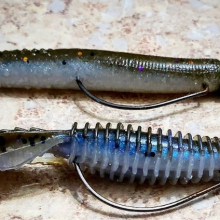
Ned rigs continue to grow in popularity as more and more anglers realize just how effective they are.
Ned rigs really excel when bass are not keen on chasing larger faster moving lures such as crankbaits and topwater lures.
The produce fish all year long. Big largemouth in deep cover or smallmouth over a gravel bed next to a drop off the Ned rig really does produce.
What you need to make a Ned rig:
- 1/16 or 1/8 ounce mushroom style jig head
- 2.5 inch soft plastic stick bait or worm
Tackle tends to lighter than your average bass combo so a good Ned rig rod will need to have a light power rating and a fast action for added sensitivity. Ultralights rod are okay but can prove too light when fishing around heavy weeds.
What is a Ned Rig?
A Ned Rig is a soft plastic lure or worm that is threaded onto a mushroom shaped jig head. The jig head is weighted, whereas the material that the lure or worm is buoyant.
Ned rigs are fished mostly on the bottom with very slow movements. As they move the jig head will naturally stay down and the tail will point upwards due to its floating properties.
They are fishing on very light tackle, which is commonly referred to as finesse bass fishing.
Who Created the Ned Rig?
The Ned Rig was created by Ned Kehde who was a strong advocate for finesse bass fishing in the mid west as early as the late 1950’s.
During the 1980’s Ron Linder introduced Kehde to a small mushroom shaped jig head.
Kehde originally used to cut Z-Man’s 5 inch ZinkerZ worm in half before there were dedicated ned rig baits available.
The thing that made the Z-Man’s soft plastic so unique was that it had a natural buoyancy to it. This allowed for the tail of the lure to float upwards whilst the Ned rig hook jig head would sink.
When on the bottom the jig appeared to have it’s tail in the air and it’s head burrowing into the lake floor making it look like some kind of bottom feeding creature.
How to Fish a Ned Rig for Bass
In open water you fish a Ned rig by casting it out and allowing it to sink, the jig head is then slowly twitched along the bottom in a very soft and delicate manner.
There are a number of different retrieval types for the Ned rig but the one above is the most simple to master.
It is actually more difficult than you think as most bass fishermen will become impatient ad will start to twitch it too quickly.
For best results the Ned rig is fished low and slow through the water.
You are not trying to run the jig too quickly. Stubborn bass do not like quick moving lures especially once the water temperatures start to drop.
They can be fished off the bottom, simple cast towards cover and allow them to sink, more often than not bass will hit them as they slowly sink downwards.
Ned rig fishing is all about making a subtle presentation. Try to make as little splash or noise as possible.
When most bass anglers strike to set the hook they do so with a rather violent jerk of the rod tip. This is not the way to set the hook of a small jig like a Ned rig.
Instead you should lightly lift your rod tip and reel in at the same time. This allows the hook to set without ripping it out of a bass’s mouth.
Tackle Considerations
A finesse Ned rig setup although ideal will normally be too light for bass if you are working around or in deep weed cover.
You still need a rod with a bit of backbone but light enough to be able to use small jigs. Look for a light/medium power rating with a fast action.
You can pair that with either a size 2000 or 3000 spinning reel. Main line can be braid or fluorocarbon as both have very little stretch.
If using braid then you should tie on a fluorocarbon leader.
How to Tie a Spinnerbait Rig
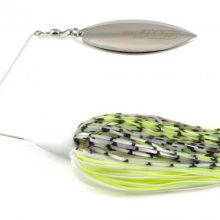
Spinnerbaits in the right hands can be one of the most effective lures available particularly in and around deep and heavy cover.
Lots of anglers complain that they never end up catching much when using spinner baits despite buying a dedicated spinnerbait rod and having a large selection of lures to choose from.
I see a lot of anglers rigging their spinnerbaits incorrectly which an lead to the blades failing to spin.
But;
Just how exactly do you tie a spinnerbait rig ?
This will depend on the type of loop that you have on the spinnerbait. Some will come with a closed loop and others with an open tie on loop.
The preference is to always buy a spinnerbait lure that has a closed loop as it can avoid a lot of the problems associated with using open loop tie on points.
How to Tie a Spinnerbait Rig
The best way to tie a spinnerbait rig is with an improved clinch knot directly to the eye of the bend.
The only time you should use a snap link is when the spinnerbait has a closed ‘R’ style loop as the tie in point.
If you are using a spinnerbait rig that has an open style loop then using a snap link can run the risk of the snap running freely up towards the blades and stopping them from spinning.
Another reason to not use a snap link or clip when rigging a spinner bait is that a lot of spinnerbaits are considered weedless lures.
If you use a snap link then the snap itself can pick up quite a bit of weed especially if you are dragging it through very fine weed beds.
However, if you do want to use a snap link then you need to make sure that the snap will not run up towards the blades, this is a real problem when using an open style loop.
There are two ways to stop the snap link from moving out of the loop, both approaches effectively do the same thing which is to turn the open loop into a closed loop:
Use a small rubber band and loop it around the open side of the loop
- Similar to the rubber band above you can wrap some heavy monofilament behind the snap link to close the loop.
I have also seen knots running up when using an open loop spinnerbait. Tying on a spinner bait with a weak knot can result in the knots running up and down the wire.
One way to avoid this is ti use a small dab of superglue on the knot once it is tied on.
This should stop it from moving assuming it has been tied correctly. Always be careful when using super glue to not get any on your fingers.
Frog Fishing for Bass
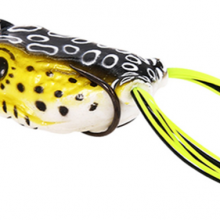
Without question top water frog fishing for bass has to be one of the most exciting forms of freshwater fishing.
Seeing a largemouth bass engulf your frog from below will get any anglers pulse racing.
You can throw them in and around heavy cover, twitch them across open water and put them under low hanging trees and docks all to great effect.
There are some subtle differences in how you fish a frog lure in each of the scenario’s above.
Knowing what size and how to retrieve it can have a massive impact on your strike rates.
Your tackle also needs and upgrade to be able to handle all that weed and other potential snags.
The best frogging rods will have need to have a stout backbone so a heavy power rating is a must.
You’ll need a fast to extra fast action so that every move of your rod tip is translated quickly to the frog and it will also set the large single hooks most of these lures have.
Ideally it should be 7 feet or more in length a longer rod gives you better casting performance but also a bit more control as you will be working the lure on the top of weeds and lilies.
A main line choice will always be braid. The heavier the better, 50 lb braided line is not uncommon particularly in very heavy vegetation.
Braid slices through weeds much easier than mono or fluoro due to it’s thinner diameter.
It also has close to zero stretch which is crucial not only for setting your hook, but translates your rod movement more directly to the frog.
Frog Fishing for Bass
Frog fishing for bass means getting you frog right up in heavy cover were frogs would naturally be hiding, it is crucial that when you move it across the water that it generates some noise and splash.
A lot of noise and splash will help the bass to see or locate your frog from below.
If you are fishing a frog lure in open water then you may need to drop down a size, but in heavy cover sometimes the bigger the better as you can cause a lot more disturbances with the larger one.
How to Fish a Frog Lure
Fishing a frog lure involves casting it towards and into cover, the frog is then walked or popped across the top with regular pauses during the retrieve.
More often than not a bass will strike the frog during the pause phase of your retrieve.
This pause can be crucial to your success. Not pausing does not give a bass a chance to have a good look at it and think about striking.
Pausing however needs to be done properly. Try not to pause for too long in open water.
For example in a large mat of lilies there can be gaps in between them, make sure to pause here only for the briefest of moments.
You don’t want to give the bass too long to inspect your fake frog as they may decide against it.
The same holds through when fishing in open water.
When you do go to set the hook often a slight pause is best, sometimes up to 2 to 3 seconds.
Pausing for this long can seem counter intuitive but you will be rewarded with a higher hook up rate and that is what is important.
It takes a few milliseconds for a bass to properly engulf a lure like a frog and setting your hook to quickly will result in just ripped it straight out of the bass’s mouth without the hook bedding in.
1. Thick Cover
For the majority of bass fishermen frog fishing means working their frog across the top of heavy vegetation or cover.
That could mean a variety of different types of cover:
- Lily pads
- Heavy weed
- Pond scum
Thick cover frog fishing means making a lot of splash and noise.
Whilst smaller frogs are more suitable to open water when fishing in thick cover use a big frog as it will make more noise and create a lot more splash.
A lot of anglers will throw a frog at cover and then just mindlessly reel it back towards themselves.
More often than not this type of approach is hurting their success.
Frogs don’t swim in straight lines at the same speed all of the time.
When working this type of water you should be using a weedless lure.
If you are in a boat facing at the bank of the lake then you can cast the lures right up to the waters edge of the bank.
Some anglers will even cast onto the bank and then skip or hop the frog into the water to simulate a frog entering the water from the land.
This would not be possible without a weedless lure!
Once in the water then vary your retrieve to pop the frog forwards and out to the side by varying the direction of your rod tip.
Allow a slight pause and then continue with the same action varying each pull to make them look a bit more natural and random.
2. Open Water
Open water is not what most people associate frog fishing with.
But, it can be very effective.
This is where using a slightly smaller lure will pay dividends. The smaller lure creates less splash and in open water too much splash would look unnatural.
To help this kind of presentation you can use slightly lighter line. In thick cover strong line that can slice through a lot of weed is essential but in open water not so much.
This is also where a hard body frog will really shine, especially those that have legs that kick when moved through the surface.
You want the appearance of the frog to be as natural as possible so a smaller lure that generate smaller wake as it if fished is best.
If the wind is blowing then after a certain speed it will be creating too much ripple on the surface.
Bass in this scenario are relying on their sight and your lure to create a bit of wake on the water surface.
Too much wind and you won’t get nearly as many strikes as in calmer waters.
3. Along Drop Offs
Identify a drop off on your fish finder or by sight if it is shallow and a clear day and then work the lure along the contours of the drop off.
This approach will work best of their is vegetation on the hallow side of the drop off.
Bass love vegetation as cover and in the right scenario will break that cover to smash a topwater lure like a frog.
This approach can beat out thick cover frog fishing on certain days and I find it usually depends on the light conditions and how much wake the wind is causing on the surface.
Too much wind and it’s not that effective.
4. Around Docks
Fishing for bass in and around docks is nothing new. In fact most kids will either start fishing off of a dock or in a small river.
Fishing with frogs however is not that common place.
Saying that it can be very effective, not sure why but it works.
Just like fishing in open water you should aim to use a slightly smaller frog.
Work the frog along the side of the docks and even underneath them if the structure allows.
6 Bass Fishing Rod and Reel Setups
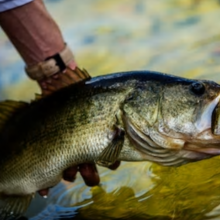
As you progress as an angler at some point you will start to out grow your first rod and reel setup and look to purchase some more specialized gear.
For a lot of fishermen having a few rod and reel setups to hand is more than commonplace.
Bass tournament anglers on the other hand take it to a whole other level with up to 20 setups on a boat during a pro comp
Different techniques do call for different rod lengths, powers and actions. If you really wanted to you could have a separate rod and reel for every imaginable type of bass lure and rig.
But;
Not only would that become a pain to store and transport, your credit card would also take a severe beating.
If you have been fishing for bass for any length of time you may well of heard of the 6 rod bass fishing system.
So what is the 6 Rod and Reel Bass Fishing System ?
The 6 Rod Bass Fishing System is six different rods and reels of varying actions, powers and lengths that can cover most if not all of the most common ways to catch bass.
Each rod can cover roughly one to three different types of techniques, together they should be more than adequate for any recreational angler.
If you were to be limited to only two bass rod setups then the medium power spinning setup and a medium/heavy power baitcasting rod would give the ability to cover a wide range of bass fishing techniques.
6 Bass Fishing Rod and Reel Setups
1. Medium/Heavy Casting Rod Fast Action 7′
This rod is suitable for use with Texas Rigs and as a bass jigging rod. Single hook lures need a fast action as you will need to be setting the hook as quickly as possible.
Jigging also requires a fast action so that you can get as much action through the rod tip and down to the jig to give it some life.
The medium/heavy power is required especially when you are throwing jigs or heavier rigs in and around thick cover.
2. Medium Power Spinning Rod Setup 6’9″
When using lighter lures or rigs you are often better off using a bass spinning rod with a medium power rating. Generally below 7′ feet in length.
A good bass spinning reel will be a size 3000 for general work.
This can be used with small plastic swimbait lures, small jerkaits or any other small topwater lures and some of the lighter rigs like a ned rig or shaky head rig .
This type of setup also makes a great drop shot rod providing the action is fast.
3. Heavy Power Casting Rod X-Fast Action 7’3″
If you are throwing frogs, big swimbaits and flipping and pitching in and around heavy cover then a heavy power baitcasting rod is essential.
A fishing frog lures the is a high possibility that you will end up in heavy weed cover and all the best frogging rods need a lot of backbone.
A heavy power rating is also essential for a good pitching and flipping rods even though you are working close up to cover that extra length can give you a bit more power to steer bass away from thick weeds.
The best swimbaits are usually larger lures so your swimbait rod needs to be able to handle these larger lures and should be paired with a decent swimbait reel in the 300 or 400 size range.
4. Medium Power Casting Rod 7′ Moderate Action
If you are casting any kind of slow moving lure with large treble hooks on them then a more moderate action is a must.
Fast action rods are suitable for single hook lures or rigs as you need to set that hook quickly.
With large trebles it is best to delay that strike for a few milliseconds as often if you strike too quickly you can end foul hooking a bass somewhere on the head.
A more moderate action means a softer hook set which is ideal for larger crankbaits or jerkbaits.
5. Medium/Heavy Casting Rod Moderate/ Fast 7′
This type of setup is suitable for larger single hook lures such as spinnerbaits and swim jigs.
The best rods for spinnerbaits will have a medium/heavy power rating as they are lures that create a lot of drag through the water and you need a bit of backbone when using these types of bass lures.
A more moderate action is also suitable as a topwater rod for lures with larger treble hooks.
6. Medium Power Casting Rod X-Fast 6’9″
When using a lure that requires a lot of added action by twitching the rod tip such as a jerkbait then you will get the best results with a rod with an extra fast action.
Most jerkbait rods will fall under the fast to x-fast rod action range.
That means a lot of sensitivity through the tip and the slightest twitch of the rod should be transmitted quickly through your line to your lure.
Top water lures also need such and action if using a topwater frog in and around heavy cover however you should be using a rod with a heavy power rating as it will have a lot more backbone.
Best Swimbaits for Bass
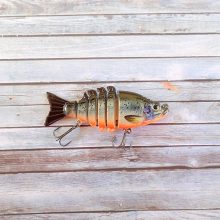
Throwing swimbaits for bass has become somewhat of an obsession for some bass anglers.
The lure of the that trophy lunker has proven just too much for some and they will happily trade lower success rates for larger fish.
Although there are plenty of smaller sized swimbaits available, for the majority once you mention a swimbait they imagine large, lifelike lures with either a jointed body or a large paddle tail.
Personally I like to use smaller swimbaits just as much as I would a crankbait or worm but when targeting really big bass size really does matter.
There are three broad categories of swimbaits to choose from:
- Hard Body
- Soft Body
- Paddle Tails
Each has there own specific characteristics but there is also a lot of cross over between the different kinds for example you can paddle tailed swimbaits with soft bodies and some can have their hooks on top or on the bottom or be multi-jointed.
A lot of the soft body swimbaits for bass will also require the addition of an added specialized weighted hook or a jig head before you can fish them.
Most hard-bodied swimbaits however will come with everything included and can have several attachment points for your line so they can be fished in different styles.
Smaller soft body swim baits can also be used as trailers on spinnerbaits.
Best Swimbaits for Bass
1. Strike King Shadalicious Swimbait
The Shadalicious swimbait from Strike King has a huge following due to it’s exceptional swimming action.
It is a hollow bodied paddle tail swimbait available in a large range of colors and 3 or 4 sizes.
AS the name suggest they make a killer shad imitator for both small and large bass.
You’ll need to rig these on a either a jig head or a weighted hook to get some decent casting distances as like most soft body swim baits they are pretty light without the addition of some kind of weighted hook.
2. Spro SB60 BBZ1
Spro BBZ1’s are some of the most lifelike lures you can buy. No self respecting swimbait fisherman would be caught without a Spro, Huddleston or a River2Sea in their tackle box.
You can rig these straight on to your line as they have a enough in built weight for casting. I tend to favor low and slow as the style of fishing for when using these.
Just be aware that those large treble hooks can snag easily on weed and other underwater obstructions so either fish them deep along a drop off or high as a topwater lure when targeting bass around weed beds.
3. Strike King Rage Swimmer
Another Strike King swimbait lure the Rage Swimmer has a ribbed body that gives off a lot of vibration even at slow speeds.
These are a great choice if you are targeting small to medium size bass and I always keep a couple to hand.
They are very versatile and can be used on a variety of different bass rigs like a plain swimbait, drop shot or you can even jig them when targeting bass close up.
They can even be used as a spinnerbait trailer when targeting bass in heavy cover.
You’ll need to rig them yourself with some added weight.
4. Keitech 4.8″ Fat Swing Impact
The Fat Swing Impact is pretty similar to the Rage Swimmer above but is available in a large range of sizes some as big as almost 8 inches in length.
They have a two tone color design with the top portion of the lure having a bit of sparkle. A really great shad type lure they can destroy bass in the right conditions.
These are rigged straight through the body for better swim action on either a weighted hook or large jig head.
5. River2Sea S-Waver 168
One of the all time classic jointed swim baits the River2Sea S-Waver has a killer swim action that is perfectly tuned to mimic small bait fish.
The 168 refers to the length in millimeters so that’s roughly 6-3/4 inches in length from tail to tip.
Targeting large lunkers means using giant swimbaits for bass in the 6 to 8 inch range and River2Sea are one of the most established players on the scene.
For best results fish them slowly just below the water surface. The resulting wake from the S like swimming pattern will draw in big bass from far and wide.
Although they have a hard jointed body the tail is actually made from hard wearing PVC so you can considered them a hybrid lure.
6. Huddleston Deluxe 8″
Huddleston are known for pouring some of the most life like swim bait patterns ever. They pride themselves on making super realistic hand painted patterns particularly when imitating small trout.
They come pre-rigged with a top hook so can be worked over the top of snags and weed beds with a lot more confidence that bottom hooked swim baits.
These are sinking swimbait lures and you can use a slow count to gauge how deep it has sunk after casting. Holding your rod tip up will help them to run shallow and they can often be smashed from below by hungry bass.
7. Storm WildEye Swim Shad 03
When bass are on the shad they can ignore just about anything else you throw at them.
Similar top hook design to the Huddleston above but much smaller lures with a built in lead head on the hook.
They also have bio-salt impregnated tails and a holographic foil finish for added attraction.
You can run these slowly in deeper waters for early season bass or over the top of weed beds in the summer as the water temperatures start to rise and bass head for shallower waters.
8. Savage Gear 3D Real Trout
One of the most realistic swimbait fishing lures you can buy the Savage Gear 3D is a paddle tail lures that maintains it’s swimming action even as it falls down through the water.
I like to fish these at several different depths on the same cast as when you pause and allow them to sink the tail continues to paddle, you can get hit by bass as you start to reel in again and they start to swim up slightly.
The internal jig head is weighted so you can control the exact swimming depth easily once you are accustomed to how quick they sink.
Available in three colors and both a sinking and slow sinking model so you can tailor your exact lure to how you want to fish it.
9. Jackall Gantarel Hard Body Swimbait
One of the most life like jointed swimbaits lures you will ever see the hard bodied Jackall Gantarel is a cut above the rest.
A fairly heavy lure so not one for use on light tackle big you be thankful as big bass love to smash these lures.
The swim action is one of the best you will ever see and the super realistic patterns are of the highest quality.
One of the most expensive swimbaits to buy these lures are for the serious fisherman only.
Both trebles come dressed in natural feathers and also come with a tail tip eye so you can run a stringer hook at the back.
Swimbaits for Bass
Throwing swimbaits for bass has become many anglers go to technique for targeting trophy fish.
The only real draw back is that when using these larger bass lures you have to realize that you will get less strikes.
A lot of small bass will quite simply ignore them and to greatly improve your chances you need to be laser targeted with where you fish them.
Big bass tend to be well distributed across any stretch of water and due to their size a certain lake or pond can only support so many of them.
Swimbait Tactics
Low and slow is generally the name of the game when using these lures for bass and it can take a few casts to fine tune the lure when it comes to how fast you should fish it.
The time of year will have a huge impact on how you fish a swimbait and it will generally dictate what depth you should be fishing at.
Look to work them in and around drop offs when looking to fish them in deeper waters earlier on in the season as bigger bass will tend to stay away from the shallows until the water temperatures begin to slowly rise during summer.
Once summer hits and bass move towards shallower waters and vegetation such as weed beds and lilies then you can start to target them in the top few feet of the water column.
Tackle Considerations
The size and weight of the lure you are using will have a big impact on the type of swimbait rod that you should be using.
Normally look to use a fast action rod with a medium to heavy power rating and length wise from seven feet all the way up to nine feet when using really big swimbaits. Swimbait reels are normally baitcasters and the bigger the better without it unbalancing your rod.
How to Fish a Swimbait
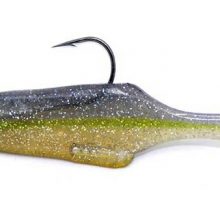
The number of swimbait designs and manufacturers has exploded since they were first championed in California in the 1990’s.
Since then bass anglers all over the country have come to embrace the swimbait as one of the best choices for targeting really big bass.
But a lot of anglers still ask the question: How to Fish a Swimbait ?
How you fish a swimbait will vary depending on the time of year and where the bass are most likely to be found. Low and slow through the water where the bass a holding.
Shallow water summer fishing will need a different approach to deeper pre-spawn season swimbait fishing.
Size and color/pattern will also play an important role but location is the first thing to get right. The best swimbaits for bass will match the hatch so to speak in terms of what patterns to use.
I like to start with a simple shad pattern and work from there.
Once you have settled on a location that is likely to hold big bass then you can figure out what kind of depth you need to be fishing a swimbait at.
How to Fish a Swimbait
A swimbait should be fished with a low and slow retrieval, running a swimbait too fast will result in it rolling on itself and spoiling the natural swimming action that is built in to it.
You can cover a lot of water when swim bait fishing and if you are not familiar with the venue on which you are fishing the using a fan like pattern with your casts can allow you to tackle a large area before moving on.
Look to run the swim bait along underwater structures or drop offs and weed beds.
One of the best swimbait fishing tips I ever received was to try and find where the shad were moving through as you can be sure that large bass will not be far behind them.
1. Deep Water Swimbait Fishing
During the pre-spawn season when bass will stay down in the deeper waters and this really is were you need to target them.
At this time of year with lower water temperatures bass will try to expend as little energy as possible, meaning they are less likely to chase a lure that is moving too fast or is too high up in the water column.
I like to use a heavier swimbait that has a decent amount of built in weight. that way you get down into the deeper water quicker and it is easier to keep them there as you work them forwards.
A slow retrieval rate is crucial when working swimbaits for bass in colder months. They quite simple will not chase anything if it traveling too fast.
So low and slow is the name of the game even though it an be a little boring at times.
2. Mid Water Swimbait Fishing
I consider the mid range of the water column to be between 3 and 5 feet. Ideally you will target a structure like a submerged log pile and cast a swimbait just beyond it.
Using a slow sinking swimbait you can gauge at what point it sinks to roughly the four foot mark and then start to haul it in slowly.
Occasionally pausing to allow it to sink a little as they will rise as they move.
3. Shallow Water Swimbait Fishing
As temperatures start to rise and bass move towards the shallow you need to start to target them in by running your swimbaits in shallow waters particulary across the tops of sunken logs or branches and large weed beds and lilies.
When casting a swimbait in shallow water with a lot of weeds around it is best to use a weedless hook or a swimbait that has it’s hook mounted on the top.
This types of lures can greatly increase you chances as when weed fouls on some swimbaits it can affect the swimming motion.
Tackle Considerations
Fishing a swimbait is basically cast and retrieve all day long so you will have a much easier time using a casting setup.
Spinning setups are fine for really small finesse style swimbaits but for almost everything else a baitcasting rod is a real must.
Rod
All swimbait rods share one thing in common and that is a fast action. You should look for a rod that has a medium to heavy power rating and should be roughly 7 to eight feet in length.
Reel
If you are using a baitcasting setup then your choice of swimbait reels should match the size of the rod and line that you are using. As long as it has a quality drag and decent casting performance you should be good.
When fishing very large swimbaits you may need to beef your reel up a little and your rod too, this may call for a specialized rod and reel.
Line
The chose of fishing line for swimbaits these days is usually a modern fluorocarbon line with a breaking strain that is normally in the 15 to 20 pound range.
If fishing in shallow waters then monofilament is just as good as it does tend to float a little better than fluorocarbon.
How to Fish a Spinnerbait
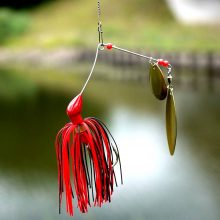
Spinnerbaits are one of those rare lures that can produce bass year round irrespective of water temperature.
Cast and retrieve is still the tried and tested method when fishing a spinnerbait, that being said you can still work them in a more start stop vertical pattern and they will still produce fish.
There are a number of different blades available as well as a wide selection of skirts. There are also tandem rigged hooks available on some spinner baits which can be effective if the bass are biting a bit short.
How to Fish a Spinnerbait
Spinnerbait fishing can be as simple as casting along cover or a drop off and simply retrieving, varying the speed of the spinnerbait can be one of the best tactics to utilize.
1. Blade Selection
There are normally three main type of blades for spinnerbaits:
- Colorado
- Indian
- Willow-Leaf
The most popular or common type is the willow with the colorado next and you will rarely see the indian.
Colorado blades are the largest of the three and create the biggest vibration through the water. They are the best choice in murkier waters, at night and in colder waters when you may want to fish your spinnerbait a bit slower.
They create the biggest amount of resistance when draged through the water and you’ll definitely feel the difference between a colorado blade on a spinnerbait and a much lighter willow.
Indian blades are effectively a cross between a colorado blade and a willow. They neither create too much vibration nor too much flash. The also spin at a speed somewhere between the two.
Best used on hot summer days when bass are more likely to be spooked by flashier lures.
If you see someone tie on a indian blade spinne rbait on purpose, then that angler really knows their blades and when to use them.
Willow-leaf sometimes just called the willow blade, these are the most slender of the three blades used on a spinnerbait. You will find that the willow blade is the most popular blade.
It spins faster than the others and because of this it has less vibration and gives off a lot more flash.
It is much easier to use a deeper depths or in and around weeds, it’s the one to choose when bass are at their most active and not to be used if the appear to be sluggish.
2. Colors
Like most bass lures you’ll find that there is a huge selection of spinnerbait colors available to buy. But spinnerbaits for bass are one of those lures where simplicity is best and keeping your colors toned down a notch is usually the safer bet.
When the waters are really clear aim to use a simple color that has a more natural color or shading to it.
Remember it is the blades that are doing most of the work when it comes to attracting bass. Using a flashy or artificial type color on a bright day with calm waters will result in lots of bass turning their nose at the spinner bait once they get close to it.
On duller days or when the waters are running a lit more brackish then you can experiment with brighter colors.
This includes the blade colors too. Painted or patterned blades can be very successful on dark days or in muddy waters.
3. Weather Conditions
Lower light days especially if there is a bit of wind can be the most productive time to fish a spinnerbait.
You can use them all year round, you’ll need to adapt the color and the blade type as described above if you intend on using a spinnerbait in summer months when the water is warmer.
4. Location
Spinner baits can be used in open water given the large amount of vibration that the blades give off.
However were they rally start to shine is near a drop off or on the end of a thick weed bed. you can also work them over the top of a weed bed that has a few feet of clear water above it.
Across the top of fallen logs especially of there are a few fallen ob top of each other can be an excellent choice as bass are very happy to lie in wait under logs in ambush of bait fish.
Tackle Considerations
Most good spinnerbait setups will be on a casting outfit and not spinning gear. The best rods for spinnerbaits will have a fast action, medium to medium/heavy power rating and be at between 6’6″ and 7′ in length.
The best fishing line for spinnerbaits is usually flourocarbon unless you are working them in and around a lot of thick cover. Then I would opt for braid as a main line with a flourocarbon leader.
Suspending Jerkbaits for Bass – Tips and Tricks
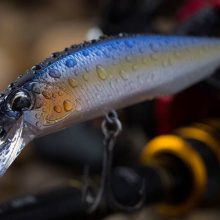
Learning how to fish a suspending jerkbait for bass can greatly increase your chances of catching a lunker especially in colder months.
In warmer months most anglers will prefer a crankbait.
Despite popular opinion jerkbaits can also be used in warmer months but bass will be in shallower waters and will happily hit faster moving lures.
During the warmer you are better off using a floating jerkbait as a topwater lure choice.
However given the choice between crankbaits or jerkbaits the majority will stick to jerkbaits in colder water temperatures and crankbaits in the summer.
What are Suspending Jerkbaits?
Suspending jerkbaits are jerkbait lures that have a neutral buoyancy which allows them to stop or suspend at a certain depth once you stop retrieving them.
Like other jerkbaits the majority will come with a dive bill that helps get them down to a working depth.
A lure with a deep dive lip will be easier to get down deeper than one with a shallow lip.
Most of these lures will generally work only within a narrow range of depth. When retrieved you should be able to get them down to about 6 feet depending on the lure.
Some anglers will use a small split shot to help go deeper but this comes at a price as you will affect the swimming motion and they are technically no longer suspending lures.
One note to observe is that large swings in water temperature can seriously affect the buoyancy of any suspending lure as too can changing out the manufacturers treble hooks for after market ones.
Suspending Jerkbaits vs Floating Jerkbaits
Although the swim characteristics will be similar regardless of whether you are using a floating jerkbait or a suspending one, the real difference is what happens during the pause.
The suspending models will remain at roughly the same depth they were at just after you pause. With a floating jerkbait once you pause the lure will start to rise slowly towards the surface.
You can use the rise of the lure to great affect. Bounce it of a log or shallow rocky bottom and then allow it to rise.
This can be very effective for smallmouth bass when you are looking to work a jerkbait over the top of snags, with a floating lure you have less chance of getting snagged on the log or rocks.
Suspending Jerkbaits
The best suspending jerkbaits are designed to imitate a bait fish, the swim action and the twitch, twitch pause retrieval style mimics the start/stop pause of smaller fish and also of an injured bait fish.
Bass will routinely strike a suspended jerk baits as you pause in between the twitching movement that you impart on the lure with your rod tip.
This pause is what makes them particularly effect in colder months when water temperatures start to drop towards 40 degrees when bass tend to be at their most sluggish.
Bass are far less likely to strike a fast moving lure in the winter months.
A lot of anglers do not pause for long enough of a time to allow the bass to have a good look at the lure and then take a bite of it.
So just like your twitching motion when retrieving vary up how long you pause for too.
Water clarity also has a major effect on catching bass with a suspended jerkbait. The clearer the water the better especially in colder months.
There is no major vibration flash given off like when fishing a spinnerbait, instead bass need clear water to see your jerkbait and then have a chance to strike it.
Even during winter variances in temperature will affect how you fish a jerbait, and you may need to adapt your technique to this.
When the temperatures really drop another common tactic is to cast out the lure and do nothing once you get it down a few feet.
This is commonly referred to as dead sticking. You allow the jerkbait to stay suspended at a certain depth, when bass are super sluggish this can be a safe bet.
Keep a close eye on your line and don’t allow too much slack to build as you may miss a strike.
Tackle Considerations
When using suspending jerk baits you will be doing a lot of casting and putting action into the lure via the rod tip. This means that you need a rod that will transmit the energy from your wrist out to the lure without any loss of sensitivity.
The best rod for jerkbaits should have a medium power rating, a fast action and roughly be 6’6″ in length.
In very colder weather you may consider a rod with a medium/light power rating as it make your strike a little lighter and prevent ripping the hooks.
The best jerkbait line is flourocarbon for it’s low stretch characteristics and low visibility. Mono has far too mush stretch in it for this type of technique. If you do decide to use braid instead of flourocarbon fishing line then make sure to use a flourocarbon leader.
How to Fish a Jerkbait
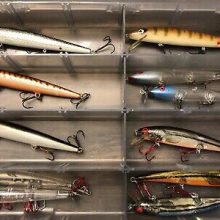
Jerkbaits really come into their own when the temperatures start to drop. How to fish a jerkbait is a common question among beginners.
A lot of beginners understand the concept but not always the finer details of the execution, there are a few factors that can seriously affect your success when fishing with a jerkbait that we will discuss in-depth below.
A Jerkbait is used to imitate a small bait fish, the majority will have a dive lip on them and they can be used with nothing more than a straight forward cast and retrieve.
As the name suggest when you add a little ‘jerk’ or twitch into the retrieve especially with a pause it is only then do they really start to shine.
That pause is one of the reasons why they are so effective in colder weather.
Bass and other freshwater fish are considerably more sluggish in winter months and will favor a more slow moving, static lure much more than a fast moving one.
When fishing a jerkbait for bass the aim is to get the lure down to the right depth, twitch it in a rhythmic fashion and then pause to allow the bass to strike.
How to Fish a Jerkbait
1. Vary the Retrieve
As discussed above the common jerkbait technique is to twitch, twitch and pause.
Two twitches and then a pause.
This is an unnatural movement pattern for the lure. Mix things up a little, twitch three times then pause, then one twitch and a pause.
Also vary the angle that your rod tip is pointing.
This will make the jerk bait move in a much more natural way. Twitch to the left a few time then the right and even directly to you.
If you are covering open water then cast in a fan like pattern to cover as mush water as possible.
Chances are the bass will hit your lure from beneath allowing for a decent pause will greatly increase your chances of a strike.
2. Be Aware of Temperature
Water temperature will greatly affect the kind of depth that fish will be feeding in and also just how much energy they are willing to put in to catch a meal for themselves.
Bass will move to deeper waters in the winter as the temperature is a few degrees warmer the deeper you get.
They will also be considerably more sluggish during colder months. This is one of the reasons why a jerkbait for bass is so effective.
The pause gives them a chance to hit your lure without having to really chase it down and waste a lot of energy.
Color choices in winter should also be more natural, save the brighter ones for warmer temps.
3. Twitch on a Slack Line
Keeping your line taught whilst you twitch is not the correct technique for jerkbait fishing. Let that line go slack and allow the lure continue moving until it comes to a full stop.
Alloying the line to go slack means that the first twitch after the pause will always be some what different as you will have different amounts of slack accrued after each pause.
Far too many anglers concentrate on the twitching only, it is a two stage technique and never forget that.
4. Pause Longer Than You Think
A common mistake when using jerk baits is to only pause for the briefest of moments. Extend that pause by doing a slow count of one to three seconds.
Just like varying the retrieve you should also mix up how long you pause a jerkbait for. Remember you are trying to imitate the random movements of a small bait fish.
More often than not you as bass will attack your jerkbait on the pause so give it some time to really hone in on your lure.
5. Vary Your Depth
Needless to say if you are not on a bass boat with a fish finder then you will be guessing as to the correct depth to run your jerkbait.
Varying the depth that you run at will also mean using a variety of lures whether that’s suspending jerkbaits or floating jerkbaits it’s always good to have a selection to hand.
As a general rule in colder waters you will end up running deeper and warmer summer months you’ll end up using topwater lures more often.
6. Use Flourocarbon Line
Personally I consider flourocarbon as the best line for jerkbaits, you get the invisibility of mono combined with the stiffness of braid.
That being said if you are using a floating jerkbait and are only looking to target the very top of the water column then mono can be a good choice as it floats.
It you do decide to use braid then make sure to use a flourocarbon leader as you’ll be working the lure over the top of the bass and they can see braid pretty easily from below.
Do Jerkbaits Work in Summer?
Yes fishing a jerkbbait in summer works really well. Work the jerkbait with a higher speed than you would in winter and be much more aggressive when twitching it.
You can also experiment with much louder colors as this will help draw in bass from much further away.
Summer jerkbait fishing is all about color and flash so have a good selection of bright colors to hand.
Is a Jerkbait Topwater?
No a jerkbait is not just a topwater lure it can be fished at a variety of depths and speeds. In winter months the deeper the better and in summer months you can use them in the top few feet of the water column.
Tackle Considerations
When fishing jerkbaits you are not really tied using just a baitcasting rod a spinning rod can work just as well.
You’ll want a jerkbait rod with a fast action that will allow you to really transmit your twitching down to the lure. A medium to medium/light power rating will also help get the best action.
On really windy days I would choose a spinning combo as a jerkbait setup over a baitcaster as there is less chance of wind knots especially if you are using braid as a main line.
Crankbait vs Jerkbait – What’s the Difference?
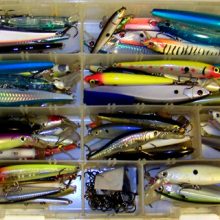
Most bass anglers will keep a large selection of both crankbaits and jerkbaits in their tackle boxes, both can absolutely slay large bass when the conditions are right.
But, what exactly is the difference between crankbaits and jerkbaits?
Crankbaits generally have a shorter fatter body shape and a variety of different styles of diving bill, whereas a jerkbait will have a longer more slender body.
Crankbaits are usually used most in summer months and jerkbaits in winter months but this is not a hard and fast rule.
Crankbait vs Jerkbait
Crankbaits have a shorter, stubbier body shape, will generally only have two treble hooks while a jerkbait on the other-hand will be longer and more slender and can have up to three treble hooks.
Depending on the season and water conditions how you fish a jerkbait will vary as too will a crankbait.
However, jerkbaits are generally fished with a lot more action added by ‘jerking’ or twitching the rod tip and then pausing.
Crankbaits can also be fished in this style but they are more often than not cast along or near some kind of structure and retrieved in a more regular fashion.
Crankbaits are also a popular choice for trolling with as there running depth can be easily controlled by either the speed the boat is running at or the use of a downrigger.
Body Types
As mentioned above the body of a jerkbait will normally be longer and thinner than a crankbait.
Traditionally both would have been made out of balsa wood.
These days however, manufacturers have switched to using hard plastic more and more for jerkbaits but for crankbaits there is still a lot that are made from balsa wood.
Running Depth
When comparing jerkbaits and crankbaits most anglers would say that a crankbait will run deeper than a jerkbait due to the larger dive bills that crankbaits can have.
However, things aren’t always that simple. You can get sinking jerkbaits and these will run deeper than a floating crankbait.
When you compare the two types of lures that have a neutral bouancy the suspending jerkbait will in fact running more shallow than the average crankbait.
Jerkbaits are fished with a pause, and if you are using a floating model then that pause can allow the lure to float back to the surface slowly so because of this jerkbaits can be used in the top three feet of the water column much easier than a crankbait.
Diving Bills
The dive bills on a jerkbait are generally of the same size and shape across most different models.
On a crankbait there are various sizes and shapes. How deep the lures will run will vary by both the size, shape and by how aggressively down-turned the dive bill is.
The dive bill and shorter body on a crankbait will also give it a more aggressive swim action than a jerkbait.
Hooks
The fact that jerkbaits are longer on average than a crankbait means that on larger models they will usually have three treble hooks as apposed to the more regular two on a crankbait.
A lot of anglers like to switch out the stock hooks for higher quality hooks, you need to be careful when doing this as replacing the manufacturers hooks with heavier after market hooks can affect the swim characteristics of both jerkbaits and crankbaits.
Tackle Differences
Most fishermen will run slightly different setups when using a jerkbait or a crankbait.
For example on an average jerbait setup your typical jerkbait fishing rod will have a faster action than a crankbait rod to allow for the fact that you twitch the lure to add some life into it.
Whilst monofilament is normally favored for crankbaits the go to fishing line for jerkbaits will be fluorocarbon due to it’s lower stretch and lower visibility.









